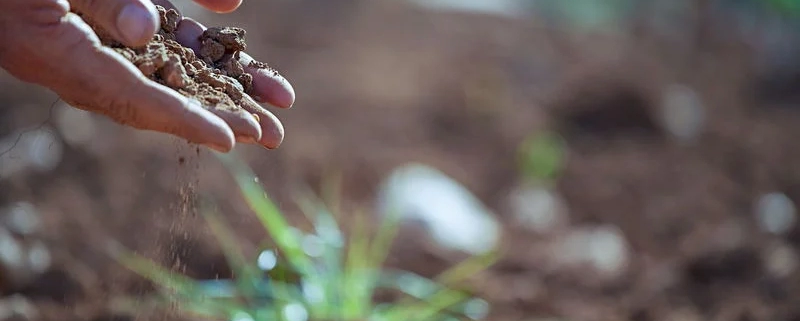Nutrients and Organic Fertilizers
To grow produce organically in your home garden, you will need natural fertilizers.
While nutrient requirements may vary between crops, as a general rule, if you start with good, fertile soil, and if you practice good soil conservation techniques like multi-cropping, you can keep soil that way without having to heavily fertilize on a frequent basis. Most dry organic fertilizers like compost and manure are slow releasing, so start your planting season by boosting your nursery beds by adding such fertilizers.
The type and amount of fertilizers required will depend on specific growth phases of plants, and on which part of the plant you intend to harvest. For instance, fertilizers rich in nitrogen aid in profuse foliage (leaf) growth, so leafy green crops will do well with a nitrogen rich fertilizer (or naturally benefit from companion cropping with legumes). Nitrogen is also required by any plant when developing leaves. When crops bloom (flower), they require potassium and trace elements. Perennials, root crops, trees require more phosphorus. Calcium-rich fertilizers (such as those using egg shells) are useful for plants whose fruits you harvest, like tomato, which can otherwise become calcium deficient.
Traditional Farmyard Fertilizers
Most plants require a good dose of the nutrients NPK (Nitrogen, Phosphorous, and Potassium). Compost, Panchagavyam, and Jeevamrutham may be used to in place of chemicals to provide plants with these three nutrients.
Panchagavyam is prepared from fresh cow dung, gomiyam (cow urine), curd, milk, ghee, and jaggery or very ripe (fermented) fruits, while Jeevamrutham is made from cow dung, cow urine, jaggery, gram flour and top soil. These concentrated organic concoctions are very nutritious and are used as organic fertilizers. The listed contents are mixed in a drum that is covered with a sack to allow for aerobic processes to take place. After 3 to 4 days, the mixtures are ready to be used and need to be diluted in ratios of 1:100 or 1:500 to feed the soil, in the case of Panchagavyam, or sprayed on plants, as with Jeevamrutham. Both these nutrient dense supplements increase the flowering and fruiting when sprayed just before the respective seasons.
Since some of the ingredients of these two traditional fertilizers are hard to procure for urban dwellers, especially in small quantities, urban gardeners usually pool in and come together to prepare them for their gardens. If you don’t have a lot of gardening neighbours who can join you in making these at home, you can always buy these concoctions ready-made in organic retail stores who source them from rural farmers. You can also order them online on Amazon, or from one of the service provides listed in the Urban Thottam Directory.
If you are purchasing organic fertilizers, they will often come with instructions on how much and how to apply them. Liquid fertilizers like panchagavyam are sold in concentrated form and will need to be diluted before use.
Panchagavyam is best used after plants have established themselves (not during transplanting) and is easy to add along with water when irrigating your plants – you can use diluted Panchagavyam every 2 weeks or so.
Home Made Fertilizers
Compost (NPK)
Compost can easily be made at home from kitchen waste and can be used to fertilize and keep plants healthy. A fistful of compost can be be added by ‘side dressing’ (sprinkling around the base of the plant) every 3-4 weeks. See section on Home Composting to learn more.
Banana Peel Fertilizer (Potassium Rich)
Instead of discarding banana peels, dry them in the sun until they turn deep black in colour. Once fully dried, powder the peels using a blender/grinder and keep aside for use as a fertilizer. If you’re in a hurry and peels have not dried completely, they may also be slow roasted in an oven at low heat or dry-stirred on a stove top to remove any leftover moisture. This banana peel fertilizer is a rich source of potassium. Apply this to the soil as required.
Liquid Fruit Peel Fertilizer
There is also a wet nutrition supplement that can be prepared from banana peels. To make this supplement, soak banana peels in water for 3 to four days. This sour concoction is then sprayed on flowering plants to allow the flowers to remain on the plant for a longer time, facilitating pollination. A similar supplement may also be prepared with other fruit peels such as that of mangoes. After preparing the liquid concoction, the peels may be composted. If there is a dearth of plants at flowering or fruiting stage, then this liquid may be used as fertilizer for the roots of the plant.
Egg Shell Fertilizer (Calcium Rich)
Another simple fertilizer that can be prepared at home uses egg shells. Wash eggshells and leave them to dry. Grind the dried egg shells to get a calcium-rich natural fertilizer to use on soil near plants during the fruiting season.
Weed Tea (Nitrogen Rich)
Instead of discarding weeds, you can make a nitrogen rich fertilizer by fermenting weeds in a bucket of water. Simply add pulled weeds to a bucket of water and weight them down with a brick so that they remain submerged. Cover the bucket with a loose lid and allow to ferment for 10-14 days. Strain the weed tea to remove any weed seeds or plant matter and use the liquid, after diluting it in a ratio of 1:10, by watering around the root zones of your plants while they are growing, but avoid using a couple of weeks leading up to harvest.
REFERENCES
Personal Conversation with Kalpana Manivannan
https://gardeningtips.in/jeevamrutham-preparation-ingredients-of-jeevamrutham
https://www.littleecofootprints.com/2015/09/weed-tea.html

